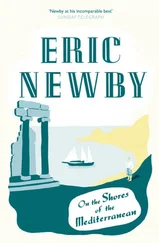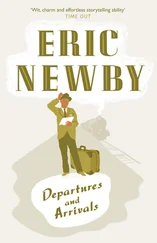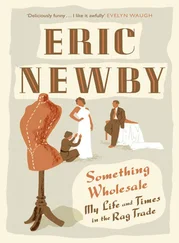‘Does he live on it?’ I asked my mother.
‘Yes,’ said my mother, ‘that’s where he lives, darling, on top of the hill.’
I was filled with an immense feeling of happiness that this radiant being, whom I had never actually seen but who was always either just around the corner or else hovering directly overhead but always invisible, should live in such a shining, beautiful place; and I asked if we could climb the hill and see him. Unfortunately, the train was due and we had to hurry to the station. I cried all the way to it and most of the way back to Bembridge. I never went back to Godshill and I never will.
I can remember, in July 1923, being carried high on my father’s head through the bracken in the combes that led down to the beaches on Sark, and once having reached them I can remember falling down constantly on the rocks and hurting myself, I considered, badly. And it was on Sark that I had my first remembered nightmare, in the annexe to Stock’s Hotel, a charming, ivy-clad, farmlike building. I awoke screaming in what was still broad daylight with the sun shining outside my first-floor room in which the blinds were drawn, to think myself abandoned to a dreadful fate by my parents who were dining only a few feet away in the hotel, certain that I had ‘gone off’ to sleep. It was a nightmare of peculiar horror, because it was founded on fact; so horrible and at the same time so difficult to explain to anyone that for years I dared not confide the details to anyone, and to my parents I never did, although it recurred throughout my childhood, together with an almost equally awful one about falling down an endless shaft.
1 It was originally intended that the church should be built at the foot of the hill near the site of the present village. However, when work was begun on it, the plan was vetoed by a band of local fairies. As a practical expression of their objection whenever the walls reached a particular height they proceeded to knock them down and carry the stones up to the top of the hill where they rebuilt the walls, after which they danced round them in a ring. After this had happened three times, the workmen who had on each occasion been forced to demolish the walls, carry the stones back down the hill and then build them up again in the low ground, lost heart and decided to build the church where the fairies wanted it to be built. As a result of this wise decision there was much jubilation among the fairies and when the church was finally completed they held a great fête on top of the hill to celebrate their victory, the sounds of their revelry being audible at a considerable distance.
CHAPTER THREE Rings Around the Tombs in SW13
(1923)
This hideous dream I last dreamt, after an interval of fifteen years, while escaping from the Germans in Italy in the autumn of 1943. It derived from an incident that occurred in the spring or early summer of 1923, the same year that we went to Sark. This incident took place in Barnes while I was on an outing with my nurse in what used to be called a mail cart or Victoria carriage. A mail cart was a machine made for the conveyance of children who have outgrown their prams, as I had, but were still unable to cover long distances on foot, bearing the same relation to a push chair as a Hispano-Suiza to an Austin Seven. In it the infant occupant sat upright with his back as it were to the engine, in this case whoever was pushing the thing. With the hood up conversation between pusher and pushed was precluded, unless the pusher stopped pushing and walked round to the front of the vehicle. It was in some ways a beautiful vehicle, the product of the pre-industrial revolution coach-builder’s imagination and just as an electric brougham looked like a brougham that had lost its horse, so a mail cart looked like a Regency curricle which had lost its horses and was being pushed back to the stables by human hands.
My pusher was called Lily. She was my first and last real nurse. I can remember everything about Lily without the aid of photographs; but the photographs confirm that she was what I thought she was, even at that early age, a very good-looking in a soppy kind of way, raven-haired, distinctly friendly girl with dark rings round her black eyes. I have already referred to her in another book, Love and War in the Apennines , but she has to be resurrected yet again for the purpose of this narrative.
Lily had been kitted out by my mother in what must have been a moment of social aspiration in full nurse’s rig. The winter outfit, navy-blue coat and a sort of pork-pie hat to match which she wore at a jaunty angle, was innocuous enough but the summer one was very different. It consisted of a short-sleeved blue-denim dress with starched white collar and cuffs, black silk stockings, high heels and a headdress made up of swathes of dark-blue veiling. Dressed in this outfit, a model girl’s idea of a W1 or SW1 nurse, with the veiling and the black-rimmed eyes, she looked like a mixture of a houri and nurse in a blue film. In London, W1, or SW1, where nurses, in fact, tended to be rather plain, if not hideous or of forbidding demeanour, she would have been very conspicuous and they would probably have driven her from Hyde Park, if she had attempted to enter it, into that desert where nurses whose charges did not appear in Debrett were sent to languish, Kensington Gardens. In Barnes, SW13, the total effect of the uniform, Lily and her soppy, friendly air could have been nothing less than inflammatory. I loved Lily but even then at that tender age I recognized that it was in a different way from anyone else who ever looked after me; and I think Lily loved me, but in a different way from the way in which I loved her. Thus, because of all this, in her company, as a sort of accomplice or accessory after the fact, because I could easily have told my mother what was going on, I found myself being trundled to assignations, only one or two of which I can remember fully, with what I recall as old men (which meant that they might have been twenty years old) and my mother recalled years later when I was fully grown as ‘dirty old men’ (which probably meant that they were over forty).
The venues for these presumed encounters, for I never remember seeing any actual goings-on, were the towing path above Hammersmith Bridge near Chiswick Ferry which was grassy and on which a number of bushes grew, and a creepy and now desecrated and presumably deconsecrated cemetery on Barnes Common. In it Lily kept me quiet while, again presumably she made rings around the tombs, by giving me handfuls of Carrara marble and other more brightly coloured chippings to play with. Some of these tomb chippings found their way into my bath where they were discovered by my mother. Subsequent sleuthing led to Lily being surprised by my mother, whether while being about to ‘do it’, or while actually in the act of ‘doing it’, or simply being chatted up, whether on the towing path or in the cemetery or at some other trysting place, she never made clear. Whatever or wherever it was, Lily was instantly dismissed, although this was not until some time towards the end of 1924, the year following the events which I am now narrating.
Whether it was in pursuit of whatever she was in pursuit of, or we were simply on a new, adventurous walk, on the afternoon on which the happenings which led up to my nightmare took place, Lily pushed me in the mail cart up the towing path from Hammersmith Bridge as far as Chiswick Ferry. The ferry was for foot passengers only, and when it functioned at all, which was rarely, they were conveyed across the river by a ferryman in a rowing-boat. Having reached the ferry, as she usually did, Lily turned left down a narrow, unmetalled lane between two reservoirs from which it was separated by iron railings. This lane led to Lonsdale Road, the road up which the police used to push the drunk and disorderly on their handcart to Barnes Police Station. At Lonsdale Road she normally turned left for Hammersmith Bridge and home along the pavements. But on this particular day instead of doing this she crossed Lonsdale Road and continued to follow the alignment of the lane into what was, for me, unknown territory.
Читать дальше












